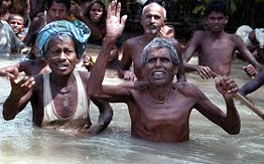Global assessment report on disaster risk reduction 2015
 An investment of US$6 billion annually in disaster risk management would result in avoided losses of US$360 billion over the next 15 years says this fourth edition of the United Nations Global Assessment Report on Disaster Risk Reduction (GAR).
An investment of US$6 billion annually in disaster risk management would result in avoided losses of US$360 billion over the next 15 years says this fourth edition of the United Nations Global Assessment Report on Disaster Risk Reduction (GAR).
 The fourth edition of the United Nations Global Assessment Report on Disaster Risk Reduction (GAR) is a resource for understanding and analyzing global disaster risk today and in the future. The report explores the large potential losses from disasters currently face by many countries - especially those which can least afford to invest in future resilience and the cost and benefits of disaster risk management (DRM). It emphasizes as well the close link between disaster risk and sustainable development and explores prospective, corrective and compensatory risk management approaches as a way to integrate it in development activities, in order to avoid risk generation and accumulation. The report aims to promote the integration of Disaster Risk Management into development by raising the awareness that managing risks cost less than managing disasters.
The fourth edition of the United Nations Global Assessment Report on Disaster Risk Reduction (GAR) is a resource for understanding and analyzing global disaster risk today and in the future. The report explores the large potential losses from disasters currently face by many countries - especially those which can least afford to invest in future resilience and the cost and benefits of disaster risk management (DRM). It emphasizes as well the close link between disaster risk and sustainable development and explores prospective, corrective and compensatory risk management approaches as a way to integrate it in development activities, in order to avoid risk generation and accumulation. The report aims to promote the integration of Disaster Risk Management into development by raising the awareness that managing risks cost less than managing disasters.
Related Content
- Confronting Carbon Inequality: Putting climate justice at the heart of the COVID-19 recovery
- Making Cities Resilient report 2019: A snapshot of how local governments progress in reducing disaster risks in alignment with the Sendai Framework for Disaster Risk Reduction
- Making Cities Resilient report 2019: A snapshot of how local governments progress in reducing disaster risks in alignment with the Sendai Framework for Disaster Risk Reduction
- Global wetland outlook: state of the world’s wetlands and their services to people 2018
- Words into action guidelines: national disaster risk assessment
- The Sustainable Development Goals report 2017
